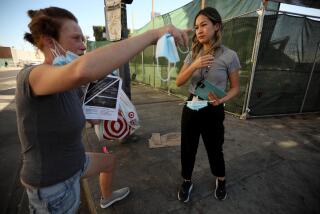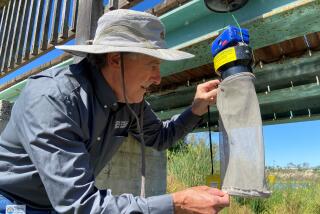Reaching a ‘Forgotten Group’: Women With AIDS : Meeting Will Bring Them Together With Experts
- Share via
IRVINE — The college-educated woman, just 30 years old and already drawing a $40,000 annual salary as an insurance underwriter, had modest dreams: finding a good husband, settling down, starting a family. She’d just met a great guy--the first one, in fact, that she had ever really cared for.
All she had to do was take a test for HIV. No big deal. Just to be safe.
Though nine months have passed, she’s still trying to shake off the shock. Not only did the test come back positive, she learned she already has full-blown AIDS.
“I was . . . on a career path,” said the Irvine woman, who figures she contracted the disease in college, from one of six sexual partners in her life. “I have a great family, good friends. Then all of a sudden--bam! It basically destroyed my life. I don’t even feel I have a life.”
It’s one thing to know intellectually that AIDS is not just a disease of gay men and drug abusers, but quite another, as this woman discovered, to live with the day-to-day reality of a diagnosis.
Being a woman with AIDS in Orange County--where females account for 6% of the more than 3,400 cases reported--can be an isolating experience. Many women with AIDS and the human immunodeficiency virus that leads to it crave not just practical information but some kind of connection to others like them, doctors and AIDS service providers say.
One of the main purposes of the third annual “Women and HIV” conference set for Saturday at UC Irvine is to put women in touch with AIDS experts, and with one another.
The all-day conference was organized by the South Coast Medical Center Foundation and the UCI Health Education Program because women and men often have very different experiences, both medically and socially, with the disease.
“Women have been the forgotten group,” said conference moderator Pearl Jemison-Smith, a former UCI nurse who heads the Orange County HIV Planning Advisory Council. “There haven’t been the services, the attention to details” that have characterized the response to AIDS in gay men, she said.
Though gay men have battled the stigma of AIDS with some success, women still “are seen as whores and ‘those awful IV drug users,’ ” said Laguna Beach psychologist Valerie Gold-Neil, who helped start the annual conference.
Among the more than 200 Orange County women who have reported cases of AIDS since the early 1980s, the most common risk factor is heterosexual contact with an infected partner, according to statistics from the Orange County Health Care Agency. Intravenous drug use is a close second.
Health officials say the percentage of total cases among women in Orange County is only about half the national proportion of 12%. But they caution that women’s share of the caseload has slowly climbed from 6% of reported cases in 1991 to more than 8% last year.
As of March, 1993--the latest date for which projections were available--700 women in Orange County were believed to be HIV-infected.
*
HIV is often the farthest thing from physicians’ minds when they are treating working, middle-class women, one UCI gynecologist said. But it shouldn’t be.
“It always surprises me how women will . . . be exposed, go to their doctors and have them say, ‘No, you’re not that kind of girl,’ ” said Dr. Beverly Sansone, who is scheduled to run a conference workshop on treatment of HIV-positive women.
Part of the problem, for women in particular, is that the early symptoms of HIV infection can have many other explanations. Unless a doctor has been trained to suspect HIV, a test might not be ordered until a patient is well into the disease process.
The Irvine woman with AIDS, who asked not to be identified because she fears discrimination, said she had been treated by doctors for recurrent yeast infections, an abnormal pap smear and shingles--a virus that causes painful blisters along nerves. But “it never entered my mind that I could be at risk” for HIV infection and it apparently did not occur to her doctors either.
“Unless you fall into some type of category, they don’t even think” of HIV, she said.
The woman said she would still be in the dark if it hadn’t been for her new boyfriend’s request that she be tested before becoming sexually involved with him. “I would have kept going, got an opportunistic infection and died,” she said.
In addition to educating doctors about women’s symptoms and needs, the conference is also designed to help women get what they want from physicians. Many women want more information about, and control over, their treatments, but find themselves tongue-tied in the doctor’s office, physicians and conference organizers said. Others wonder whether they should risk having children who could be infected with the virus.
*
One timely topic that will be discussed at the conference is the promise and potential pitfalls of using the drug AZT during pregnancy to prevent transmission of the virus to newborns. Results of a study released in February of 364 babies found that the rate of transmission dropped from 25.5% to 8.3% when women took AZT during pregnancy and labor and the child received it for six weeks after birth.
But doctors say women should be aware that many questions about the treatment remain unanswered, including whether the drug causes birth defects. The Bethesda, Md.-based National Institute of Allergy and Infectious Diseases, which sponsored the trial, made no recommendations about the treatment because its long-term effects are still unknown.
It also isn’t known whether women must take the drug for as long as the study subjects did, from the fourteenth week of pregnancy on, said Dr. Carol Major, a UCI perinatologist. Nor are researchers sure whether transmission was reduced because the mother took AZT before birth or during birth, or because the child received it afterward, she said.
For all the uncertainties in the scientific realm, women need to know that having a child is still an option for them, said Tamara Lindley-Brown of Costa Mesa, who has had HIV for 13 years but gave birth 3 1/2 years ago to an uninfected son.
“A lot of people want to have children,” she said. “What about that woman who’s always had a maternal instinct?”
Beyond the medical and scientific realm, Saturday’s conference also will address the legal, ethical, the spiritual and the emotional. Comedienne Suzanne Wilson, who has HIV, will do a closing presentation entitled “Laughing in the Face of AIDS.”
Organizers said this year’s conference will be especially attentive to the needs of minorities, including Latinas, who account for more than a quarter of all cases of AIDS reported among Orange County women. One address and two workshops will be in Spanish.
“We’re very much trying to be more inclusive than ever,” Jemison-Smith said.
Women With AIDS Women makeup about 6% of the nearly 3,400 cases of AIDS reported in Orange County since the epidemic began. Half of the women who have contracted AIDS have died. A portrait of women and AIDS in Orange County as of June 30.: *
1993 cases per 100,000 Orange County: 4.7 California: 11.1 United States: 15.4 *
Age when AIDS diagnosed 19 and younger: 5% 20-29: 21% 30-39: 44% 40-49: 17% 50-59: 5% 60 and older: 8% *
How AIDS contracted Heterosexual sex: 41% Injected drugs: 36% Transfusion: 14% Pediatric: 4% Unknown: 5% *
Ethnicity White: 61% Other: 1% Asian: 1% Black: 9% Latina: 28% *
Attending the Conference The Third Annual Women and HIV Conference will take place at the UCI Student Center. The public is welcome: Date: Saturday Registration: 7:30 a.m. Conference begins: 8:30 a.m. Cost: Health professionals, $35; general admission $30; students, $10 Information: (714) 499-7229 Selected topics: Impact of Diversity on HIV and Women; Ethics, Law and HIV; Children and HIV; Ob/Gyn Care in the HIV-Positive Woman Sources: Orange County Health Care Agency, Diease Prevention & Control; Researched by CAROLINE LEMKE / Los Angeles Times
More to Read
Sign up for Essential California
The most important California stories and recommendations in your inbox every morning.
You may occasionally receive promotional content from the Los Angeles Times.










